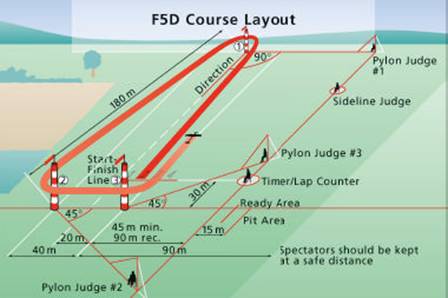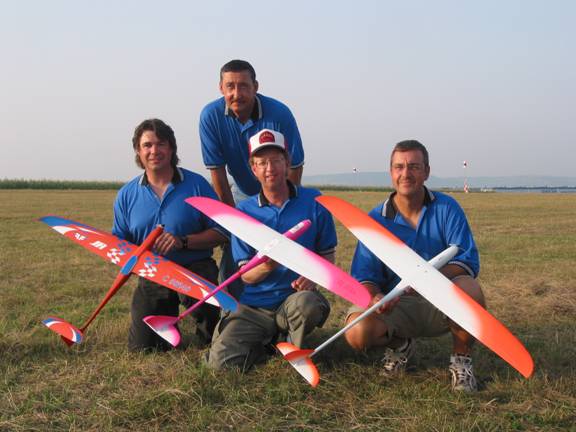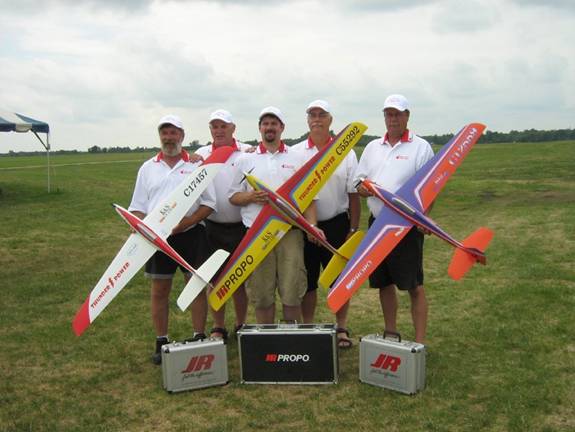
July 29, 2012
Click here for the general FAI information article
The FAI consists of affiliated countries and each country is limited to one national aero club as a member. If there is more than one airsport active in a country they must form a single organization (national aero club) to represent them at FAI.
The Aero Club of Canada (ACC) is the member for Canada. Its members are the national associations of each airsport activity. It is simply an association of Canadian airsport organizations.
For aeromodelling, MAAC is our representative in the ACC. Other representatives are the Soaring Association of Canada, Hang Gliding and Paragliding Assoc of Canada, Canadian Sport Parachuting Assoc. of Canada, Canadian Sport Aeroplane Assoc., and Canadian Balloon Assoc.
The ACC sends a delegate to the FAI General Conference each fall to represent the interests of Canada.
The FAI organizes World Championships for Aeromodelling every two years. Eligibility to compete is governed by the FAI as a whole but the rules for each event are established by the FAI Aeromodelling Commission (CIAM). MAAC sends a delegate to the Plenary Session of the CIAM each spring to represent the Canadian Aeromodellers. Rule changes in any event can only be made by CIAM.
The CIAM has established rules for about 40 classes and organizes World Championships in about half of them.
THE AIRPLANE
Maximum swept volume of motor or motors: 2.5 cm3
Minimum total area (st): 2 dm2/cm3 swept volume of the motor(s)
Maximum loading: 100 g/dm2
Maximum wing span: 100cm
They are usually assymetrical airplanes with the major part of the wingspan on the inboard side of the model. (This is limited, however, by a formula found in the rules.)
The models are very streamlined, with a fully cowled in engine mounted on a metal pan, with a compulsory silencer/tuned exhaust assembly and engine shut-off.
The engines are usually glow engines, and run on contest supplied fuel consisting of 80% methanol and 20% castor oil.
The models are flown on two (2) controls with a minimum diameter of 0.40mm and a length of 17.69m.
THE CONTEST
The contest consists of three (3) official flights which are timed over a course of 9 laps = 1 km.
During the official flight the control handle must be placed in the fork of a swivelling pylon, which is located in the centre of the circle in order to prevent whipping.
Timing starts two (2) laps after the pilot has successfully positioned the handle in the fork of the pylon. He must then attempt to fly the model no higher than 3 metres above the ground, or less than 1 metre for more than one lap, for the remainder of the timed course.
The flight is disqualified if he removes the handle from the pylon fork once the timing commences, or the model does not remain within the specified height limits mentioned above.
The single highest speed clocked by a competitor is used to determine the winner, and all other subsequent placings.
THE AIRPLANE
Maximum total flying weight (excluding fuel): 3.5 kg
Maximum wingspan (overall): 2.0 m
Maximum length (overall): 2.0 m
Permitted power sources include any power except rocket motors. Piston engines shall have a maximum swept volume limitation of 15 cm3. Electric power shall be limited to a maximum no-load voltage of 42 volts. Gas turbine engines shall be limited to 10 n static thrust.
The line length can be a minimum of 15 metres to a maximum of 21.5 metres. (the lines are subjected to a pull test of 10 times the total weight of the model without fuel.)
No wireless methods of control for the flying surfaces or engine shutoff are permitted.
Engine throttles or speed controls are not allowed in the competition.
THE CONTEST
The flight pattern which is performed by each competitor consists of 16 manoeuvres, all of which must be performed in the order shown in rules, and within a timed flight period of 7 minutes, which includes the time taken for the model to roll to a complete stop after landing.
The manoeuvres to be performed consist of a mixture of wingovers, round and square inside and outside loops, inverted flight, round and square horizontal eights, vertical and overhead eights, finishing with a four leaf clover, and landing.
The contest consists of three rounds, out of which the best two flight scores are added together to make a total score to give the final placing of competitors.
In world championship events, the best fifteen (15) competitors are allowed into the fly-off rounds where an additional two flights are flown by each finalist.
The total of the two fly-off flights are added together to make a total score to give the final placing of competitors.
THE AIRPLANE
The maximum swept volume of motor(s): 2.5 cm2
Minimum total projected surface area (st): 12 dm2
Total maximum weight: 500g
Minimum dimensions of the fuselage at the pilots location: HEIGHT 100mm, Width: 50mm, cross sectional area: 39 cm2
The model must be of semi-scale design, and its general lines must be similar to those of a full scale aircraft.
The model must carry a pilot with minimum dimensions:
Height: 20 mm, length: 14 mm, width: 14 mm
Minimum diameter of wheel(s) 25 mm
Maximum fuel permitted: 7 cm3 (diesel engines are usually employed in this event because of the fuel restriction noted).
The engine must be entirely enclosed in the cowl, including the cylinder head and the body of the carbureter.
A cockpit or transparent windshield giving direct forward visibility for the pilot is required.
Engine shutoffs are mandatory.
A two line control system is required, with a minimum 0.30 mm line diameter.
The line length required is 15.92 m
THE CONTEST
Three competing teams fly simultaneously in each race, after having been drawn for order by the contest officials.
A team consists of a pilot, and a pit man. The latter is responsible for starting the engine and refueling the model during a race.
The qualifying races are of 100 laps duration, and are preceded by a 2-minute warm up period, and a 30-second cool down period. Engines are test run and warmed up at this time, and are then shut down before a heat commences.
Once the signal is given by the circle marshal to begin the race, all competitors can start their engines and take-off as soon as they are able.
The timing begins at the start signal, and finishes when a team passes the timer(s) at the hundredth lap.
A minimum of one refueling stop is required in a 100 lap race.
The flying height in a heat is a maximum of two to three metres, except when passing.
Rule infractions such as whipping, high flying, blocking etc. Can lead to disqualification after three fouls have been committed by a team during a heat.
Final races are of 200 laps duration, and the three teams with the best race times recorded are selected for this round.
A minimum of three pit stops are required in a final race, but four fouls are allowed per team due to the longer duration of the race.
The top three places in competition are decided by the timed results of the final race. All other contest places are scored by the best result of each team in one of their three preliminary rounds or semi-final rounds.
This multi-task event requires the pilot to fly three different tasks; namely, Duration, Distance, and Speed in each round.
The Duration task requires the pilot to fly the model for exactly ten minutes and land as close as possible to a designated spot for maximum points.
The Distance event requires the pilot to fly the model in the four minute working time to cover the 150 meter course as many times as possible.
In the Speed task the pilot must fly the model four times over the 150 meter course as fast as possible.
A minimum of nine rounds are flown during the World Championship event.
The same model is flown in all three tasks launched by a specially build electric powered winch. The model design must be light, aerodynamically clean and exceptionally strong to withstand the launching forces and speeds that can exceed 200 km/hour. Ballast can be used depending on weather conditions but the model loading cannot exceed.
F3J Thermal Duration Glider Class
This class is very popular as it is a single task event. The pilots try to keep their models in the air for exactly ten minutes and then land as close as possible to a designated spot for maximum points.
Launching the model is by hand towing, usually a two person team, using a 150 meter long monofilament line to pull the model up to a ping and zoom finish that gives at least 200 meters of height at the start of the flight.
The pilots are divided up into groups, using a matrix format, so that they compete against as many others as possible. Then the top pilots fly in a single group in the Fly-Off to determine the winner.
Specific rules for the above classes can be downloaded from the FAI Site: www.fai.org/aeromodelling/book/export
THE AIRPLANE
Maximum weight: 6 kg (except where the model represents a prototype of more than one engine, then it shall not exceed 7 kg.
Motive power: rocket or pulse jets may not be used, and maximum thrust for a turbine engine is limited to 6 kg.
The model is a scale replica of a man carrying heavier than air aircraft, and must be flown on a two wire control system attached to the primary controls mechanically.
Secondary flight functions can be activated either automatically, by extra wires, or by electro-magnetic pulses sent through the wires/cables providing that they do not exceed 30 khz.
The line length allowed is a minimum of 15 metres, and a maximum of 21.5 metres.
The model's outline, detail, and colour scheme must be authenticated by documentation, drawings and/or photographs which have been certified by an authoritive source. (the documentation etc. Is also known as "proof of scale")
THE CONTEST
The aim of the contest is to duplicate the appearance and performance of a particular full-scale aircraft prototype, And have this scored by a panel of qualified judges.
The contest is scored in two parts: static judging for the scale appearance and craftmanship of the airplane. Then the scoring of three (3) official flights which demonstrate the scale flying characteristics of the model.
the two best flight scores are then added together along with the static score to decide the final placing of the competitors.
The static scoring portion of the event is broken down into subsections which judge the scale accuracy, colour, markings, surface texture and realism, craftmanship and scale detail.
The flying portion of the event requires the compulsary manoeuvres of taxi and takeoff, 5 laps of level flight at 6 metres altitude minimum, and landing and taxi.
Four other optional manoeuvres are selected by the competitor, and these must be within the normal capabilities of the subject aircraft being presented.
These manoeuvres can include multi-engine operation, retract and extend landing gear, drop bombs or fuel tanks, High flight over 30 degree line angle, one inside loop, three inverted laps, wingover, figure eight, touch and go, lazy eight, and parachute drop.
Competitors may demonstrate one different flight Function of their own choice, but must be prepared to provide evidence to the judges that the prototype peformed the same function.
THE HELICOPTER
The model must derive all its lift from a rotor system rotating about a nominal vertical axis and that is driven by an internal combustion engine or an electric motor. Fixed horizontal stabilizers up to 4% of the lifting disc area and and controllable ones up to 2% are permitted.
They are generally of a pod and boom configuration or may have a full fuselage for streamling.
THE CONTEST
The contest consists of rounds during which various precision hovering and precision aerobatic manouvers are performed. The manouvers are scored according to well defines criteria by a panel of judges. The judges must come from different countries and be approved by the fai.
Details of the schedules may be found on the fai web site. www.fai.org
The hovering maneuvers are judged by how straight is the vertical and horizontal is the flight path the heli is flown from flag to flag as described in the maneuver, how accurate and stable are the stops over the flags and how constant are the rates of pirouettes while traveling along these lines.
The aerobatic portion is judged relative to how precise the flight path is performed, as defined by the maneuver, by the smoothness and symmetry relative to center of the maneuver and the consistency of the roll, pitch or pirouette rates required for the maneuvers.
THE AIRPLANE
Minimum weight: 1000 gr, Maximum surface loading 65gr/dm2
Maximum weight of battery pack: 425g NiCAD or NiMH, seven cells maximum
There are no restrictions on the electric motor or the propeller.
No landing gear is required
In practice, these are extremely clean models, usually molded in composite fiber materials, powered by very fast direct drive brushless motors. Wingspan is approximately 1.3m.
THE CONTEST
The course is triangular in shape 400m long measured along the three sides of the triangle. The course is 180m from the base of the triangle to the vertex. The base is 100m wide. A race consists of ten laps. Up to four models are flown in each heat. Scoring is measured against a time clock. Points are awarded as the pilot's time in seconds to complete ten laps. If the pilot cuts inside of one pylon, his time is adjusted by adding 10% to his time to obtain a corrected ten lap time. The lowest time wins. If a pilot cuts inside of more than one pylon, a score of 200 points is assigned. If four or more rounds are flown, the worst (highest) score is dropped. If nine or more rounds are flown the two highest scores are dropped.
A maximum of three model aircraft are allowed to race in each heat. The race is started with all three models being held by each pilot's helper near the start/finish line pointing in the direction of pylon #1. The pilot has 60 seconds to prepare the model for take off. After 60 seconds the Starter will signal each model to take off consecutively one after another. The timing watch begins as model crosses the start/finish line. The race is completed when each model crosses the start/finish line after completing ten laps of the course.

2006 Canadian F5D Electric Pylon Racing Team

Left to Right: Terence Palaschuk, Delbert Godon, Roy Andrassy, Peter Thannhauser
THE AIRPLANE
Weight not less than 2200gr and not more than 3000gr
Total projected area of the lifting surfaces (wing and horizontal tail combined) shall be a minimum of 34 dm2.
Minimum wingspan shall be 1150 mm
Wing thickness at the root shall be at least 22 mm
Motor must be of the reciprocating piston type, with a maximum total swept volume of 6.6 cm3
The motor(s) shall be fitted with a silencer.
Only fixed pitch propellers may be used. Two-bladed wooden or two or more blade composite resin continuous fiber construction propellers may be used.
Fuel will be supplied by the organizers. Its composition shall be 80% methanol, 20% castor oil.
In practice, these are extremely clean models, usually molded in composite fiber materials, powered by two-stroke, internal combustion engines fitted with a full wave tuned pipe.
THE CONTEST
The course is triangular in shape 400m long measured along the three sides of the triangle. The course is 180m from the base of the triangle to the vertex. The base is 100m wide. A race consists of ten laps. Up to four models are flown in each heat. Scoring is measured against a time clock. Points are awarded as the pilot's time in seconds to complete ten laps. If the pilot cuts inside of one pylon, their time is adjusted by adding 10% to his time to obtain a corrected ten lap time. The lowest time wins. If a pilot cuts inside of more than one pylon, a score of 200 points is assigned. If four or more rounds are flown, the worst (highest) score is dropped. If nine or more rounds are flown the two highest scores are dropped.
A maximum of four model aircraft are allowed to race in each heat. The race is started with all four models resting with their wheels on the ground at the start/finish line pointing in the direction of pylon #1. A helper holds the model while the pilot has 60 seconds to start and adjust the motor. After 60 seconds the Starter will signal each model to take off consecutively one after another. The timing watch begins as the Starter signals each model to take off. The race is completed when each model crosses the start/finish line after completing ten laps of the course.
2007 Canadian F3D Pylon Racing Team

Left to Right: Murray Hamula, Henry Redekop, Jeremy Voth, Richard Moldenhauer, Harold Sattler